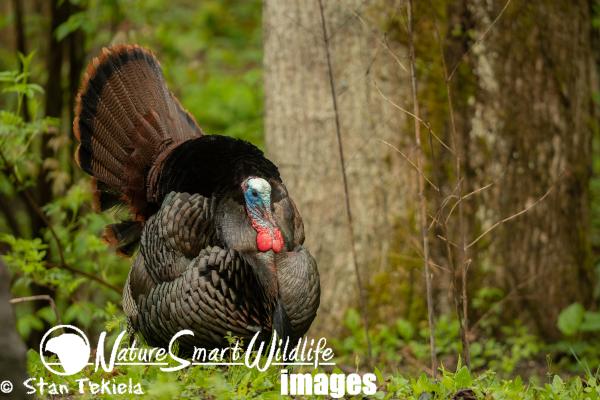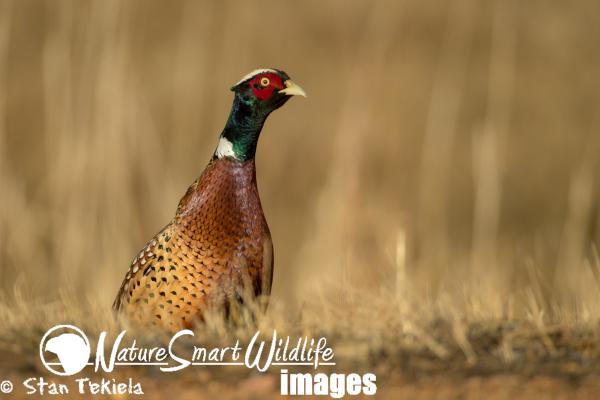View all of the titles in the
NatureSmart Bookstore


by Stan Tekiela
© NatureSmart
July 2, 2018
It has been a very busy spring. I’ve been traveling extensively and giving numerous presentations to thousands of participants across 5 states. I really enjoy getting out to meet so many people who come to my presentations and enjoy nature as much as I do.
My speaking engagements usually last just over an hour or so and are followed by a short question and answer period. I get all sorts of questions ranging from “What is my favorite bird” to how do I capture specific images. But recently I was asked a question that really set me back on my heels. I could almost not believe what I heard.
The question started out more of an observation and went something like this. “I’ve been seeing more and more turkeys than I have ever seen before in my life. They seem to be over populating. And I am not seeing as many pheasants as I have in the past. I’ve heard that turkeys seek out pheasant nests and kill the eggs and baby pheasants. Why don’t we reduce the number of turkeys to help out the pheasants?”
At first I was stunned and didn’t know what to say. There was just so many things wrong with this statement and question. All I could think about was that I had been a failure in my mission as an educator of all things wild. I managed to answer the question but not before apologizing that what I was going to as was not meant to offend or upset the person who asked the question. .
Even now, while writing this column, I am having troubles figuring out where to start answering this type of question. So here it goes again…..
Yes, you are seeing more wild turkey these days. In many states the Wild Turkey was completely killed off by 1900. It was an important food source for settlers and Native Americans alike. But because of this they were nearly driven into extinction at the hands of man. For decades we didn’t see turkeys in the wild.
This left an ecological niche that needed to be filled. So the Ring-necked Pheasant, a non-native bird originally from Asia was introduced to the U.S. for hunting opportunities. The first attempts at introducing the pheasant occurred in the late 1770’s and again in the early 1800’s. These early attempts were not successful. It wasn’t until the mid-1900’s was enough pheasants released that pheasants started to populate on their own.
Even now, hundreds of thousands of Pheasants are leased each year in many states for hunting opportunities which supplements the wild population dramatically. Some believe that without the constant release of captive breed birds the Pheasant population would decrease dramatically and perhaps the population wouldn’t be able to survive on their own. It is also said that these captive breed pheasants usually don’t live through their first year in the wild.
Meanwhile the Wild Turkey, which is a native bird, was also reintroduced to many parts of the country. Slowly over time it has moved back into former range and now can be seen all over the place. This bird does well on its own and doesn’t need supplemental releases of birds. Since they are native and evolved to this habitat it is doing well all on its own.
It is a complete myth that Wild Turkeys are hurting or killing pheasants. Extensive research by Pheasants Forever shows no effect on pheasant populations caused by Turkey’s. A single study out of Florida back in the 1930’s noted a single instance of turkey destroying quail eggs. However no biological study since then has documented turkeys damaging quail or pheasant eggs or chicks. Considering that hundreds of studies that have been done on Turkeys over the past 100 years, it is considered conclusive that Turkeys don’t influence pheasant populations.
I think pheasants are marvelous birds and just like other birds. Just because a bird was introduced into North America, we shouldn’t be playing the native verses non-native card when trying to figure out if something is good or bad. I believe all birds are good and are deserving of our respect and admiration.
The key to sustain any wildlife is first education along with strong conservation and large scale preservation of habitat. Without these key components we wouldn’t have either turkeys or pheasants. Until next time…
Stan Tekiela is an author / naturalist and wildlife photographer who travels the U.S. to study and photo wildlife. He can be followed on www.facebook.com and twitter.com. He can be contacted via his web page at www.naturesmart.com.
The nationally syndicated NatureSmart Column appears in over 25 cities spanning 7 states: Minnesota, Wisconsin, Michigan, Illinois, Ohio, New York and Pennsylvania. It is a bi-weekly column circulated to over 750,000 readers.
Wolves
Just the day before, a pack of wolves known as the Wapiti, had found a large bull bison that was weak and injured. Based on its size, this big boy was near the end of its lifespan and the winter weather was taking its toll. For a full day the wolves tried to approach the bison but when the bison...
Moose
It was one of those dark and cloudy winter days in Yellowstone National Park where the clouds are so heavy and low, you feel like you can reach up and touch the cloudy sky. A light wind helped to blow the falling snow with occasional gusts of wind causing swirls of fluffy white snow...
American Badger
It’s funny, I believe the average person knows more about the Honey Badger (Mellivora capensis), a critter of Africa and Southwest Asia than they do about the badger in our own backyard, the American Badger (Taxidea taxus). Social media has a lot to do with the Honey Badger phenomena and...
Backyard Bird Feeding
Winter bird feeding is one of the most common / popular hobbies in America. It is estimated that nearly 60 million Americans feed birds in their yards in winter or summer. That is about 40 percent of all American’s make backyard bird feeding part of their everyday activities. It’s...
View all of the titles in the
NatureSmart Bookstore
Check out Stan's latest photos at
NatureSmart Wildlife Images
Take a tour with Stan.
» More Info
Hear Stan on radio stations all across the Midwest.
» More Info

When he's out in the field, Stan relies on his Vortex Razor binoculars and Vortex Razor spotting scope to help find the subjects for his award winning wildlife photography.

For thirty years, professional wildlife photographer Stan Tekiela has counted on Hunt's Photo and Video to provide him with professional photography equipment.
From tripods to camera bodies and lenses, Hunt's has been Stan's place for everything that he needs. Personal service and prompt shipping means Stan can count on Hunt's to support his professional wildlife photography career.


Professional Wildlife Photographer Stan Tekiela always uses Feeder Fresh in his seed feeders to help keep the feeders and food dry, clean and mold free.
He also uses Feeder Fresh Nectar Defender in all of his hummingbird feeders. It safely keeps nectar fresh longer.